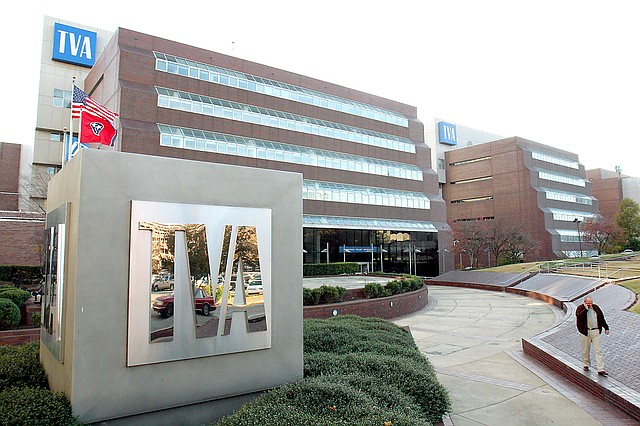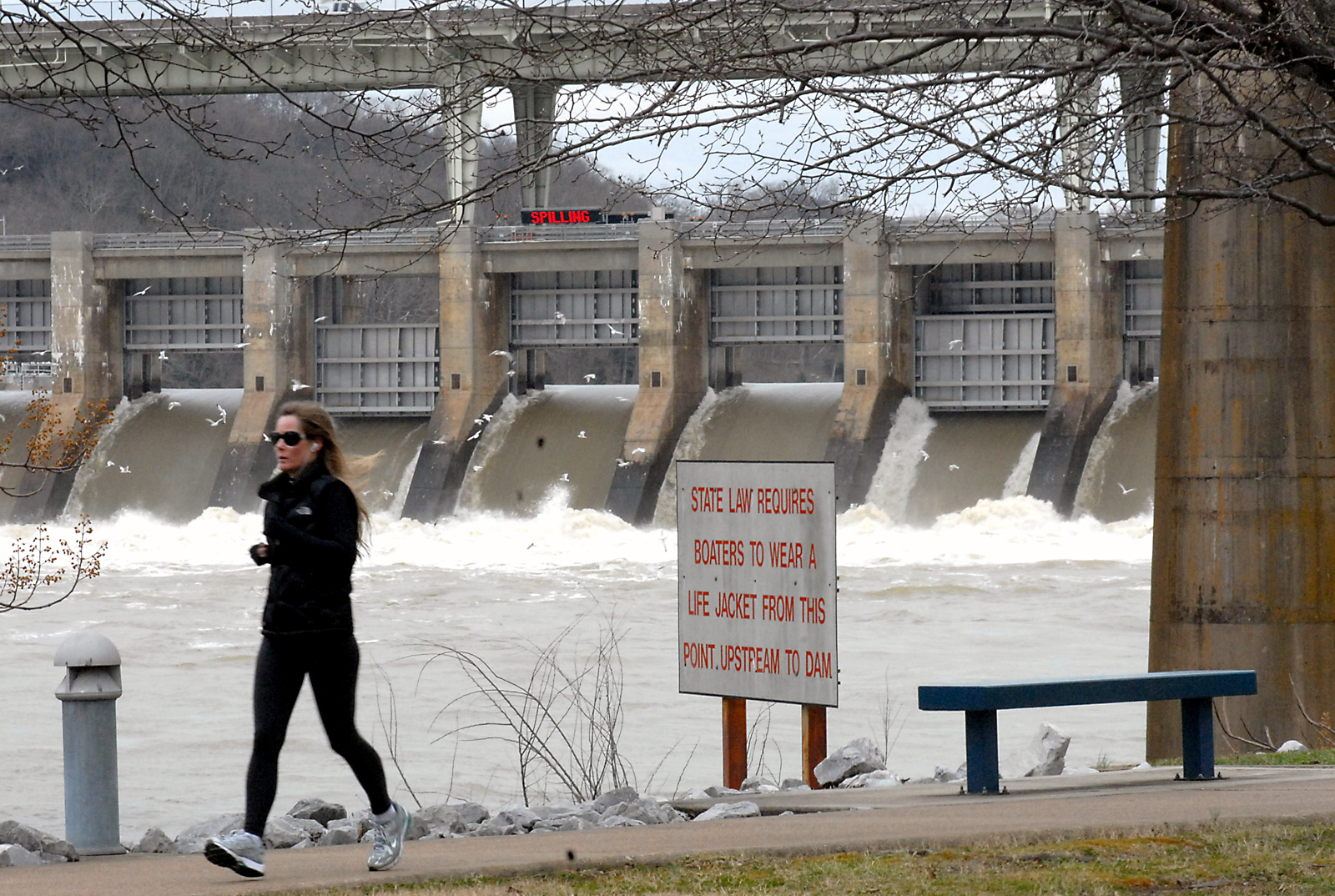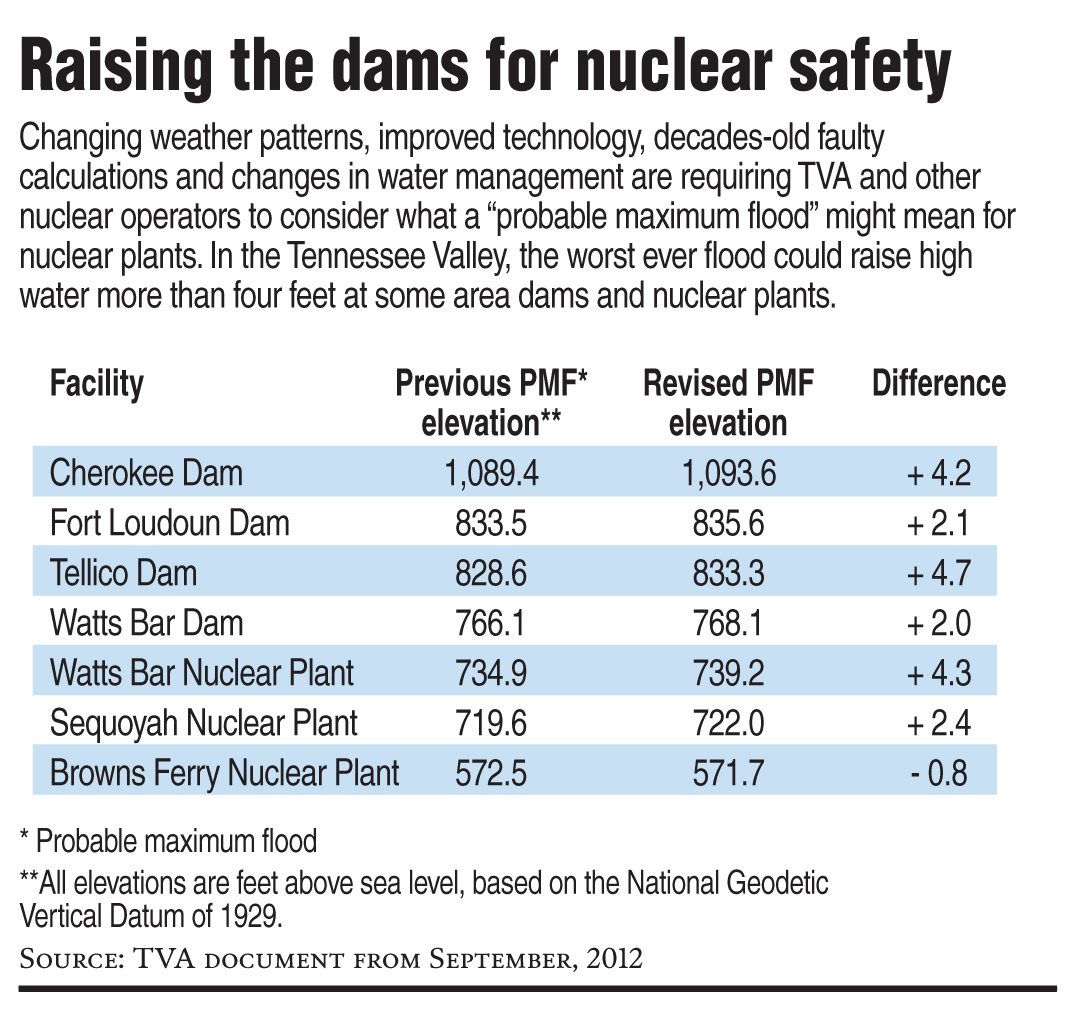Worst-case flood risk has TVA weighing higher dams
Friday, January 1, 1904
It has never happened. A wall of flood water so high that it topped dams on the upper Tennessee River and swamped emergency equipment at two nuclear plants just upriver of Chattanooga.
But government officials say recent history -- including Nashville's devastating 2010 flood and Fukushima's 2011 tsunami, as well as changing technology and past calculation errors -- make it clear TVA must plan for the worst.
Mike Eiffe, TVA program manager for hydrology and hydraulics, said preparing for a "probable maximum flood" means raising the levels of the dams and the earthen berms that flank them.
"The drainage area for Chattanooga is a little over 20,000 square miles, and for the type of flood events that we're talking about, we would be looking at an average of 15 to 16 inches of rainfall over that entire 20,000-square-mile drainage area," he said.
TVA began three years ago to put in temporary fixes, installing sand baskets to heighten the berms alongside the Cherokee, Fort Loudoun, Tellico and Watts Bar dams.
The Watts Bar and Sequoyah nuclear plants were on an NRC list of plants at risk from dam failures based on new assessments with better technologies.
But Eiffe said the temporary fixes are not intended to last 100 years, so more work is needed. Permanent proposed fixes include building concrete floodwalls and/or earthen embankments ranging from 2.3 feet to 6.6 feet high, depending on the location.
Today, TVA and the U.S. Nuclear Regulatory Commission will meet in Atlanta to talk about what "more" could entail -- at least from the nuclear safety standpoint.
Risk and cost
A probable maximum flood is defined by government experts as the flood that may be expected from the most severe combination of weather and the river's flow.
TVA earlier placed sand baskets to raise the flanks of the same four dams by 3 to 8 feet after questions arose during talk of renewing construction at Bellefonte Nuclear Plant.
In the end, TVA determined -- and reported to the NRC -- that a decades-old faulty calculation, improved technology and changes in water management raised the probable maximum flood levels for Watts Bar and Sequoyah.
The downstream embankment of Watts Bar Dam also was strengthened with concrete matting.
That $8 million to $10 million effort was made on a tight deadline with NRC to alleviate the threat of water overtopping the dams. TVA spent an additional $2 million on a study to see if other dams needed fixes.
But that was chump change compared to the alternative of shutting down the plants, which could have cost $1 million a day per reactor in lost generation.
TVA spokesmen Bill Sitton and Travis Brickey said permanent fixes could cost $20 million to $30 million.
A draft safety modification document from September notes that a public suggestion to "floodproof" the Watts Bar, Sequoyah and Browns Ferry nuclear plants with their own walls or levies would be even more costly -- as much as $1 billion.
A larger question
But all that work is predicated on saving nuclear plants, preventing nuclear damage and keeping the dams -- which also produce electricity -- standing.
Not specifically factored into the draft is saving lands, homes and businesses. A colossal 15- to 16-inch rainfall would raise the probable maximum flood level from 734.9 feet above mean sea level to 739.2 feet.
"I'm not so worried about the nuclear plants. But I think a flood like that would be a substantial threat to Chattanooga," said Hamilton County Emergency Management chief Bill Tittle.
"The weather systems are changing. We see and hear about it every day. If the Nashville rains had been a little east, that would have been us," Tittle said.
Tittle likened what could happen in the narrow section of the Tennessee River just below Chattanooga, between Suck Creek and Raccoon Mountain, to a bathtub with a slow drain.
"The water will fill up and flood a big area of Chattanooga," he said.
Officials have estimated that if such a flood did occur here, the monetary damage would be greater than in the Nashville flood.
So Tittle supports the TVA precautions.
And he said local emergency officials are working with TVA and weather forecasters to develop ways to warn residents days in advance -- just as they did three days before record tornadoes swept through the region.
"The frustrating thing is we don't have a way to stop it [the weather]," he said.
Nuclear concerns
As for nuclear concerns, TVA is not alone in having to recalculate its probable maximum flood levels around nuclear plants.
NRC, even before Fukushima, had requested flooding and earthquake safety information from all the nation's nuclear operators.
David Lochbaum, the director of the nuclear safety project for the Union of Concerned Scientists, said TVA plants have a larger safety margin with the new flood calculations than some plants.
The Oconee Nuclear Plant in South Carolina has a double-digit gap between former and revised levels, said Lochbaum, who also is a former nuclear reactor operator for TVA and a former NRC instructor.
And Lochbaum credited the NRC with possibly preventing a nuclear disaster in Nebraska when floodwaters surrounded the Fort Calhoun Nuclear Plant in 2011. An NRC inspection there the year before had found the plant did not have flood protection and procedures. The plant operators made changes that proved critical to the plant's safe operation.
TVA spokesman Ray Golden said additional safeguards also are being made at the nuclear plants themselves.
Some pumps are being elevated and seals improved around the doors, pump lines and conduits where water could leak.
There also will be some equipment modifications, and flood-mode equipment will be set aside in specific safe places so that it can be reserved specifically for use in a flood, he said.
"What we want to tell them is that we take this matter very seriously," Golden said.


